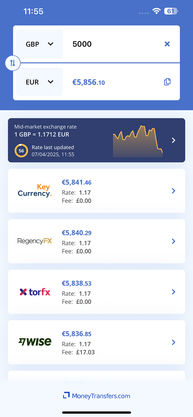When Things Go Wrong: How to Avoid Problems with your Money Transfer
Most of the time, you can expect your international transfer to go smoothly. However, we'd be lying if we said that issues don't occur for some customers.
On this page I'll explain some of the most common ways things can go wrong, or at least, not how you expected.
I'll also give you some pointers to avoid issues before they arise, and manage your expectations to prevent unpleasant surprises.
Just read the one-star reviews of any money transfer company and you'll feel the emotions jumping through the screen.
So I will recommend a simple strategy for minimising the likelihood and scale of bad outcomes: know the risks, and avoid them where you can.
I've also added a section at the bottom on how to escalate any issues if they are severe or persistent.
Transfer delays
Risk: funds are not received by the recipient on the expected time frame
Set expectations: remember that transfer timings are usually positioned as estimates. There are also certain factors, like time of day or day of week, that affect speed and are under your control.
Solutions: plan to send money in the morning, giving at least a day's margin to weekends or public holidays if you can. Make sure you have KYC documents submitted and verified ahead of time.
Unresponsive support
Risk: you need to contact support for any reason, but the response times or quality of support is not good enough
Set expectations: some providers pride themselves on support, while others try to minimise it using FAQs, support centres, chat bots and technology. Make sure you know the reputation and service approach of a company before signing up.
Solutions: choose a provider with real human support via phone or live chat. This will allow you to more quickly resolve any issues. Also be sure to test these features before sending money to make sure the service is up to par.
KYC/documentation issues
Risk: your transfer gets flagged and the company asks you to provide documentation
Set expectations: this is not unusual and doesn't mean you're being accused of anything suspicious. Especially common for transfers in the 5, 6, 7 figure range. Most transfers will require you to provide proof of ID, but your transfer may be flagged and require you provide more documentation, such as proof of address or evidence of the source of funds.
Solutions: if you're sending over $10k or equivalent, it could be worth preparing these documents in case they are requested. If over $100k, even more so.
Declined as customer or account closed
Risk: your custom is declined by the money transfer company, either before you've sent, or at some point down the line your account is closed. Funds could even be frozen for a period of time as a result - there are numerous accounts of this happening online.
Set expectations: this is a possibility, especially so with fintechs that have complex and automated risk/fraud algorithms. It's possible for your account to create a footprint that the algorithm doesn't like. Systems like this have false positives, so you may be doing nothing wrong but still get turned away.
Solutions: there isn't much you can do here, other than potentially steer away from the larger fintech services and consider smaller, broker-style companies that operate with a more human touch. You can also think carefully about how much cash you keep in any online accounts or wallets, where you could lose access.
Exchange rate changes
Risk: the rate you see when doing research may not be the rate you end up getting for your transfer
Set expectations: exchange rates fluctuate all the time - unless you're been specifically told that a rate is locked in, then it will fluctuate with the market until you lock in the transfer through your account. The rate you actually pay is also affected by any FX margin added by the provider. It's possible that this margin could also change over time, which can cause bigger cost changes.
Solutions: track the mid-market rate so you know the underlying rates for your currency pair. Also be sure to calculate the margin (the difference between the quoted rate and the mid-market rate) - push back on any provider that lets this creep up over time.
Unexpected fees
Risk: intermediary banks charge fees on your transfer that you didn't expect
Set expectations: depending on your chosen provider, currencies, and countries, local banks may be needed to route funds to the destination account. These banks may charge a fee, often in the range of $10-30 or equivalent. While not a huge amount, it's very material for smaller transfers as a percentage.
Solutions: ask the provider about this risk for your specific circumstance. If you can't get a clear idea in advance, consider trialling a few different services before deciding which one is cheapest with all costs considered.
Scams
Risk: you choose a service to send money, but it turns out to be an outright scam
Set expectations: scams do exist, though any reputable comparison site will avoid listing any unregulated services. If something seems too good to be true, or feels a bit off, it probably is.
Solutions: before signing up with any service, check its regulatory status, its online reviews, and make sure your gut isn't telling you something's off. Also take a look at our in-depth guide to money transfer scams.
How to submit & escalate a complaint
You are well within your rights to submit a formal complaint to your transfer provider if their service is not up to standard. For example:
Funds significantly delayed or not received at all by the recipient
Support failing to resolve important issues
KYC mishandled
Unethical behaviour regarding pricing and transparency of costs
Where to submit a complaint
Go through the company's own formal complaints process
Escalate your complaint to the financial regulator
Use social media - DM the company's social team or raise awareness of your concern
Submit reviews or post to forums - put some pressure on the company and share your experiences for others to benefit
Related Content
Contributors




